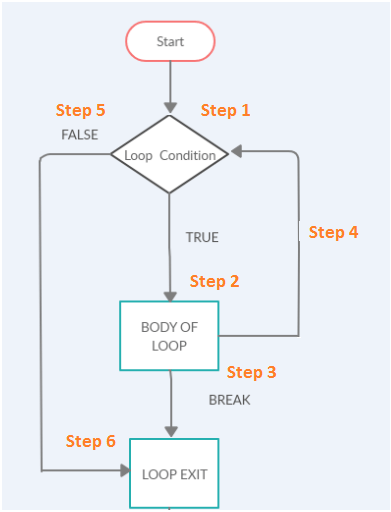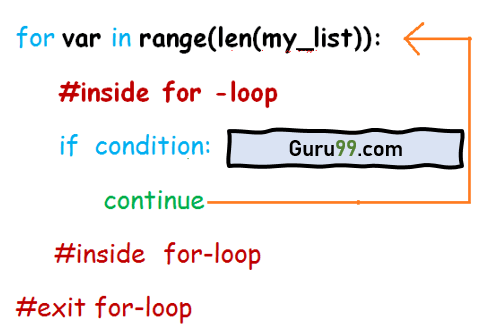Python Continue Skips Everything That Follows and Runs the Loop Again
The concept of loops is bachelor in almost all programming languages. Python loops help to iterate over a listing, tuple, string, lexicon, and a set. In that location are ii types of loop supported in Python "for" and "while". The cake of lawmaking is executed multiple times inside the loop until the status fails.
The loop control statements interruption the period of execution and end/skip the iteration as per our need. Python break and proceed are used inside the loop to change the catamenia of the loop from its standard procedure.
A for-loop or while-loop is meant to iterate until the condition given fails. When you use a break or continue statement, the flow of the loop is changed from its normal way.
In this Python tutorial, you volition acquire:
- Python break argument
- Pause statement execution menstruum
- Python continue statement
- Go along statement execution flow
- Python pass statement
- What is pass statement in Python?
- When to use a break and go along argument?
Python intermission statement
The break statement takes intendance of terminating the loop in which it is used. If the break statement is used inside nested loops, the current loop is terminated, and the menstruation volition continue with the lawmaking followed that comes afterwards the loop.
The flow chart for the break statement is every bit follows:

The following are the steps involved in the flowchart.
Pace 1)
The loop execution starts.
Footstep 2)
If the loop status is true, it will execute step two, wherein the trunk of the loop volition become executed.
Step 3)
If the loop'due south body has a break statement, the loop will exit and go to Step 6.
Step 4)
After the loop condition is executed and done, it will proceed to the adjacent iteration in Step 4.
Step 5)
If the loop condition is fake, it will exit the loop and get to Step 6.
Step vi)
Terminate of the loop.
Break argument execution flow
When the for-loop starts executing, it will bank check the if-condition. If true, the interruption argument is executed, and the for–loop will get terminated. If the condition is false, the code inside for-loop will be executed.

When the while loop executes, it will check the if-status; if information technology is true, the break statement is executed, and the while –loop will go out. If if the status is false, the lawmaking inside while-loop will get executed.

Example: Pause statement inside for-loop
The list my_list = ['Siya', 'Tiya', 'Guru', 'Daksh', 'Riya', 'Guru'] is looped using for-loop.We are interested in searching for the name 'Guru ' from the listing my_list.
Inside the for-loop, the if-condition compares each item from the list with the name 'Guru'. If the condition becomes true, it will execute the break statement, and the loop will get terminated.
The working example using break statement is as shown beneath:
my_list = ['Siya', 'Tiya', 'Guru', 'Daksh', 'Riya', 'Guru'] for i in range(len(my_list)): print(my_list[i]) if my_list[i] == 'Guru': print('Found the name Guru') intermission impress('After break argument') print('Loop is Terminated') Output:
Siya Tiya Guru Establish the name Guru Loop is Terminated
Case: Pause statement within while-loop
my_list = ['Siya', 'Tiya', 'Guru', 'Daksh', 'Riya', 'Guru'] i = 0 while True: print(my_list[i]) if (my_list[i] == 'Guru'): impress('Constitute the name Guru') interruption impress('After break statement') i += i impress('Subsequently while-loop exit') Output:
Siya Tiya Guru Constitute name Guru Later while-loop exit
Example: Intermission Statement inside nested loops
In the example, nosotros have two for-loops. Both for-loops are iterating from a range of 0 to 3. In the second for-loop, we have added a condition where-in if the value of the second for-loop index is ii, information technology should interruption.
So because of the interruption statement, the second for-loop will never iterate for 2 and 3.
for i in range(4): for j in range(four): if j==2: intermission impress("The number is ",i,j); Output:
The number is 0 0 The number is 0 1 The number is 1 0 The number is 1 1 The number is 2 0 The number is ii i The number is 3 0 The number is 3 1
Python continue statement
The continue argument skips the lawmaking that comes later it, and the control is passed back to the start for the adjacent iteration.
Syntax:
continue
Continue flow Nautical chart

The following are the steps involved in the flowchart.
Step 1)
The loop execution starts.
Step ii)
The execution of code within the loop will be done. If there is a continued argument inside the loop, the control will go back to Step four, i.e., the start of the loop for the next iteration.
Pace three)
The execution of code inside the loop will be done.
Footstep 4)
If in that location is a continue argument or the loop execution inside the torso is washed, it volition phone call the next iteration.
Step five)
One time the loop execution is complete, the loop will exit and go to step seven.
Stride vi)
If the loop condition in stride ane fails, it will go out the loop and go to step 7.
Pace 7)
End of the loop.
Continue statement execution flow
The for –loop, loops through my_list array given. Inside the for-loop, the if-status gets executed. If the condition is true, the continue statement is executed, and the control will pass to the start of the loop for the next iteration.
The menstruum of the lawmaking is every bit shown below:

When the while loop executes, information technology volition cheque the if-status, if it is true, the continue statement is executed. The control will go dorsum to the start of while –loop for the next iteration. If if the condition is false, the code inside while-loop will get executed.
The flow of the code is equally shown below:

Example : Proceed within for-loop
for i in range(ten): if i == 7: continue impress("The Number is :" , i) Output:
The Number is : 0 The Number is : 1 The Number is : 2 The Number is : 3 The Number is : 4 The Number is : 5 The Number is : six The Number is : 8 The Number is : 9
Example : Proceed inside while-loop
i = 0 while i <= 10: if i == 7: i += 1 continue print("The Number is :" , i) i += 1 Output:
The Number is : 0 The Number is : i The Number is : ii The Number is : three The Number is : iv The Number is : v The Number is : vi The Number is : 8 The Number is : nine The Number is : x
Example: Continue inside nested-loop
The below instance shows using 2 for-loops. Both for-loops are iterating from a range of 0 to 3. In the second for-loop, at that place is a condition, wherein if the value of the second for-loop index is 2, information technology should go on. So considering of the keep statement, the second for-loop will skip iteration for 2 and go on for iii.
for i in range(4): for j in range(iv): if j==ii: go along print("The number is ",i,j); Output:
The number is 0 0 The number is 0 1 The number is 0 iii The number is 1 0 The number is 1 1 The number is 1 3 The number is 2 0 The number is 2 i The number is 2 3 The number is iii 0 The number is 3 1 The number is three 3
Python laissez passer statement
Python pass statement is used equally a placeholder inside loops, functions, class, if-statement that is meant to be implemented later.
Syntax
pass
What is pass statement in Python?
Python pass is a null statement. When the Python interpreter comes across the beyond pass statement, it does nothing and is ignored.
When to use the pass argument?
Consider you lot have a role or a class with the body left empty. You plan to write the code in the future. The Python interpreter will throw an error if it comes across an empty trunk.
A comment can too be added inside the body of the function or grade, merely the interpreter ignores the comment and volition throw an error.
The laissez passer statement tin can be used inside the body of a function or class body. During execution, the interpreter, when it comes across the pass statement, ignores and continues without giving whatever mistake.
Case: pass statement inside a function
In the instance, the laissez passer is added inside the role. Information technology will go executed when the function is called equally shown below:
def my_func(): print('pass inside part') pass my_func() Output:
pass inside function
Case: pass statement inside the grade
In the instance below, we have created just the empty course that has a impress statement followed by a pass argument. The pass statement is an indication that the code inside the form "My_Class" will exist implemented in the future.
classMy_Class: impress("Within My_Class") pass Output:
Inside My_Class
Example: pass statement inside the loop
In the example below, the string 'Guru' is used inside for-loop. The if-status checks for character 'r' and calls the print statement followed by laissez passer.
# Pass argument in for-loop test = "Guru" for i in test: if i == 'r': print('Pass executed') pass print(i) Output:
Thou u Laissez passer executed r u
Example : pass statement inside if-loop
In the example the if loop checks for the value of a and if the condition is true information technology goes and prints the argument "pass executed" followed by pass.
a=1 if a==1: impress('laissez passer executed') laissez passer Output:
pass executed
When to use a break and continue statement?
- A break statement, when used within the loop, will terminate the loop and leave. If used inside nested loops, it will break out from the current loop.
- A keep argument volition stop the current execution when used inside a loop, and the control volition go back to the starting time of the loop.
The main difference between break and proceed statement is that when pause keyword is encountered, it will leave the loop.
In case of keep keyword, the electric current iteration that is running will be stopped, and it volition go along with the next iteration.
Summary:
- Python intermission and go along are used inside the loop to alter the menses of the loop from its normal procedure.
- A for-loop or while-loop is meant to iterate until the condition given fails. When you use a break or continue argument, the flow of the loop is changed from its normal way.
- A break statement, when used inside the loop, will terminate the loop and go out. If used within nested loops, it will suspension out from the current loop.
- A proceed statement, when used inside a loop, will stop the electric current execution, and the control will get back to the start of the loop.
- The master departure betwixt intermission and continue statement is that when intermission keyword is encountered, it will exit the loop.
- Python Pass Statement is used every bit a placeholder inside loops, functions, course, if-statement that is meant to be implemented later.
- Python pass is a null statement. When the execution starts and the interpreter comes across the pass statement, it does nothing and is ignored.
Source: https://www.guru99.com/python-break-continue-pass.html
0 Response to "Python Continue Skips Everything That Follows and Runs the Loop Again"
Post a Comment